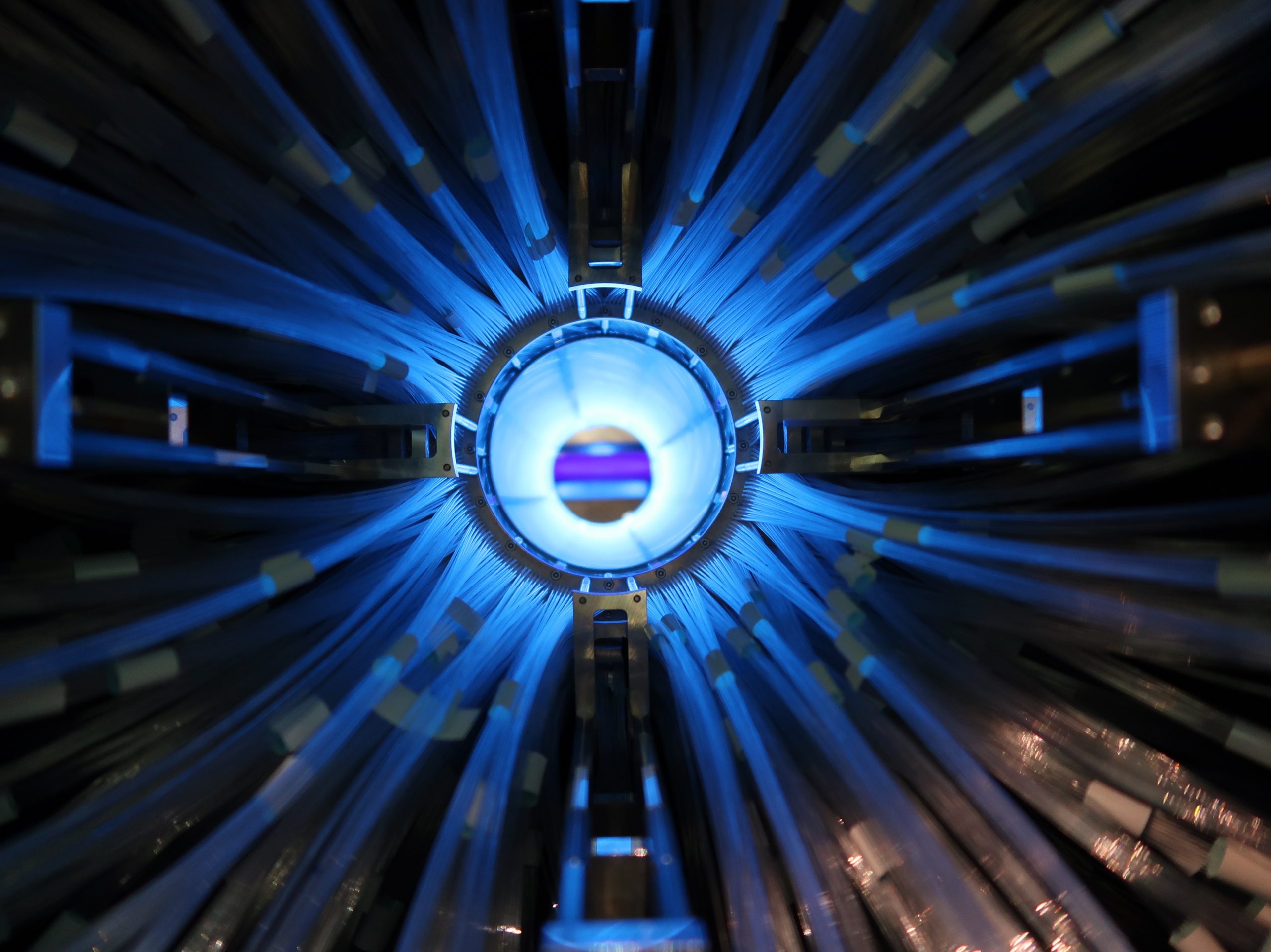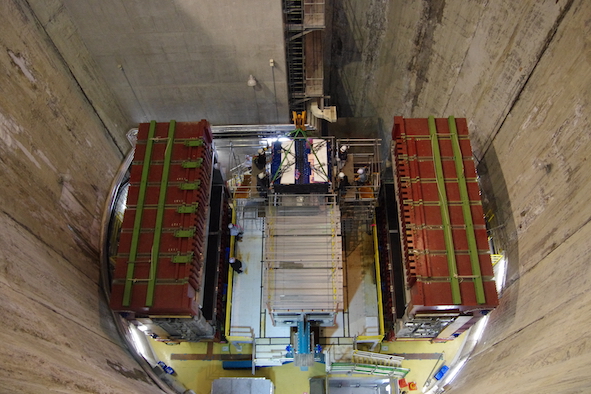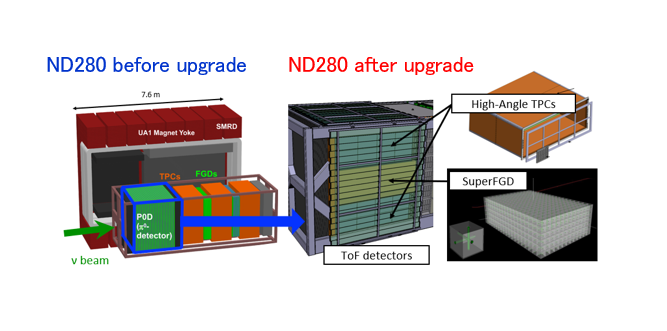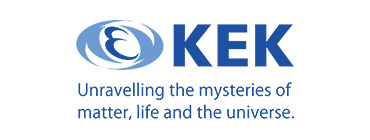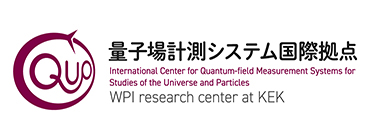- Topics
Approaching the Mystery of the Missing Antimatter from the Universe: T2K Experiment Installed New Neutrino Detectors
January 26th, 2024
The T2K is an international collaborative experiment at the Japan Proton Accelerator Research Complex (J-PARC) in Tokai, Ibaraki, with the aim of investigating neutrino oscillation (*1) precisely in order to unravel the mystery of the missing antimatter from the universe. To improve the sensitivity of the measurements, the T2K experiment started to install new detectors in July 2023, replacing a part of the near-detector called ND280. The SuperFGD (Super Fine-Grained Detector) is an ultra-precise, fine-grained track detector with a target mass of about 2 tons, allowing for a more precise detection of various neutrino interactions. The High-Angle TPCs (High-Angle Time Projection Chamber) enable precision measurements of particles emitted over a wide range of angles to the beam, which was not possible with the original detector. A new TOF (Time-of-Flight) detectors have also been installed, which can detect incoming or outgoing particles and identify particles.
Tsunayuki Matsubara and Hikaru Tanigawa of the KEK-IPNS neutrino group, who led the assembly and installation of the detector, shared the story behind the installation.
-
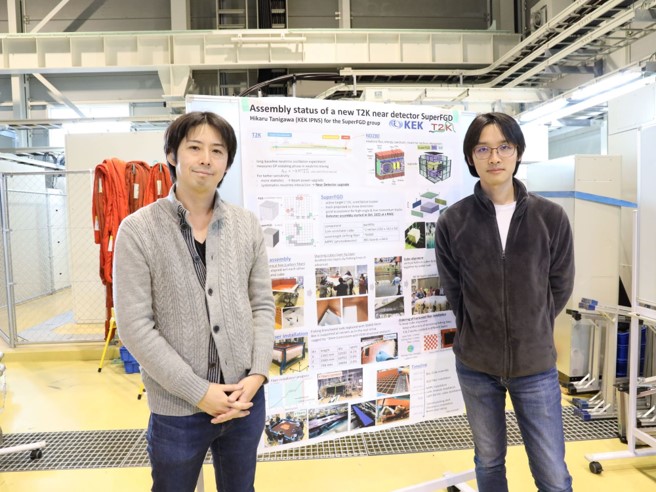
(Left) Dr. Matsubara led the improvement of the neutrino near-detectors (Right). Dr. Tanigawa joined in October 2022 and led the assembly work of SuperFGD.
SuperFGD: Ultra-Precise, Fine-grained Detector
The previous FGDs consisted of rod-shaped plastic scintillators approximately 1x1x184 cubic centimeters in size, lined up vertically and horizontally. The newly installed SuperFGD consists of approximately 2 million cubes of 1 cubic centimeter, each about 190 cm in length and width and 56 cm in height, with optical fibers running through the holes in the cubes. This makes it possible to measure, in three dimensions, which cube a particle has passed through. The T2K experiment began development of this detector around 2017, and manufacturing of each part was shared among universities and laboratories in each country. Finally, the assembly began in October 2022 at the J-PARC neutrino assembly building.
—This detector assembly work was very unique in the world.
[Dr. Matsubara] We started with building the box in which the cubes would be placed and stacking the cubes layer by layer. The cubes, about 35,000 cubes per layer, are only connected by threads horizontally and vertically, and they were all separate. We took a lot of care in transporting the cubes to prevent them from falling apart. The cubes were stacked in layers, and each cube had to have its holes aligned both vertically and horizontally, and its holes also had to be aligned with the holes in the box. Since no one had ever assembled such a detector with this concept before, we were unsure at first if it could be assembled as planned. However, we could complete it through trial and error while working it out.
— We heard that after stacking the cubes in layers, there was a process of removing the threads from each cube and replacing them with optical fibers, conducted on a two-shift basis. How much time did this process take?
[Dr. Tanigawa] It took about a month. We arranged shifts of 10 people each for the work. So, throughout the day, 20 researchers incessantly inserted the fibers into the cubes. In parallel with this work, we planned to simultaneously check the condition of the fiber in the cube, an inspection called a quality check. However, the fiber insertion work went faster than expected, and we could not keep up with the inspection of each fiber, so we had to adjust the work speed in the middle of the process.
-
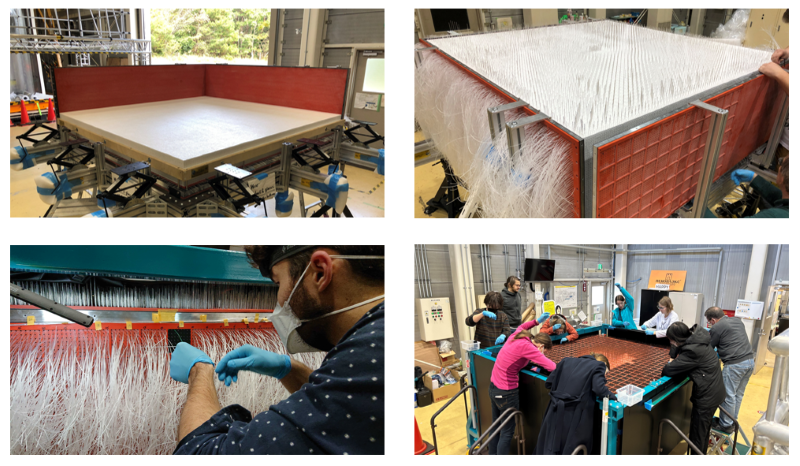
Assembly work for SuperFGD
— What can be expected from a three-dimensional structure?
[Dr. Tanigawa] The interaction between neutrino and nucleus produces charged particles. Among them, particles with short flight paths, such as protons, cannot be captured and reconstructed well with our conventional detectors. To study neutrino oscillations precisely, it is necessary to gain a deeper understanding of the neutrino-nucleus interactions. The new detector can reconstruct those particles in fine detail on a centimeter square, making it possible to measure the neutrino-nucleus interactions more clearly.
[Dr. Matsubara] By using this new-detector and measuring events such as an interaction involving the emission of low-energy protons with short flight paths more precisely, experimental errors originating from the neutrino-nucleus interactions will be reduced. We aim to eventually verify the differences in neutrino and antineutrino behavior with high precision.
-
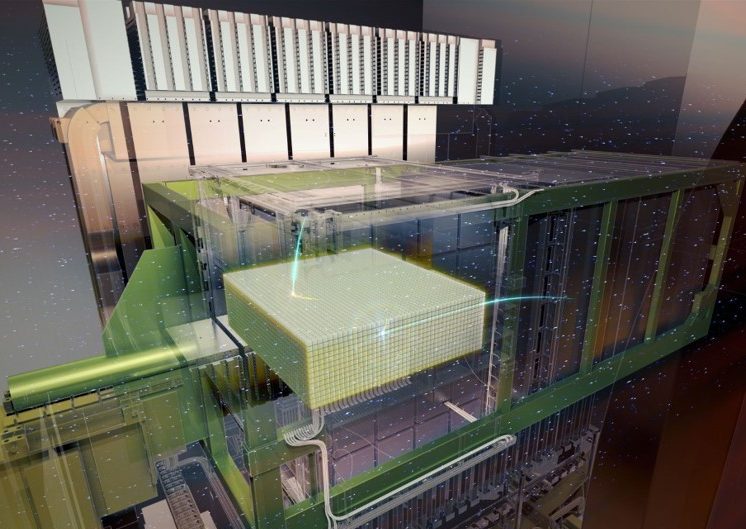
Illustration of the interaction between neutrinos and nucleus in the new detector ©J-PARC Center
New Time projection chamber: High-Angle TPCs
TPCs can detect trajectories of charged particles such as muon emitted in neutrino-nucleus interactions with high accuracy, and also measure the momentum well. The new-TPCs were assembled and commissioned at the European Organization for Nuclear Research (CERN) and transported to Japan in August 2023.
— What is the difference from the previous ones?
[Matsubara] The conventional TPCs are placed side by side in the beam axis, sandwiching the neutrino target detector, FGDs. While they are excellent for detecting particles coming out in the forward direction, those coming out in the vertical direction could not be seen clearly. The new TPCs are placed above and below the SuperFGD. This arrangement enables the TPC to clearly detect particles that emerge at a large angle to the injection beam, which has been difficult to detect previously. This is why it is called a High-Angle TPC. Other improvements have also been made to prevent electrical discharges and to make the layers of the structure thinner so that the secondary particles would not stop halfway through the structure.
-
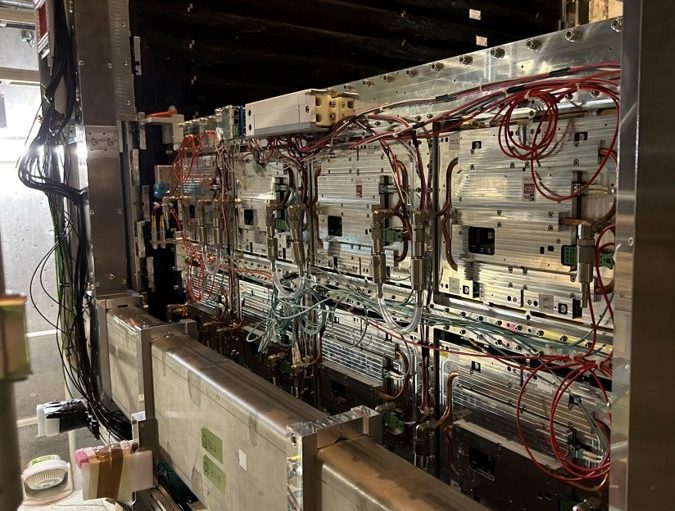
High-Angle TPC installed in neutrino near-detectors.
Time-of-Flight detectors were also newly installed surrounding the High-Angle TPCs and SuperFGD. This new detector is expected to detect incoming or outgoing particles and to improve the accuracy of identifying particle types.
Visual Journey: New Detectors Installation
-
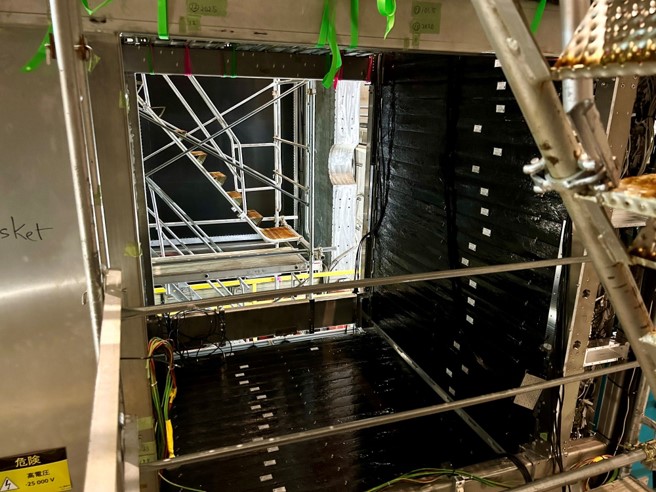
On July 5th, TOF detectors (black bar shape) were installed to measure particle time-of-flight.
-
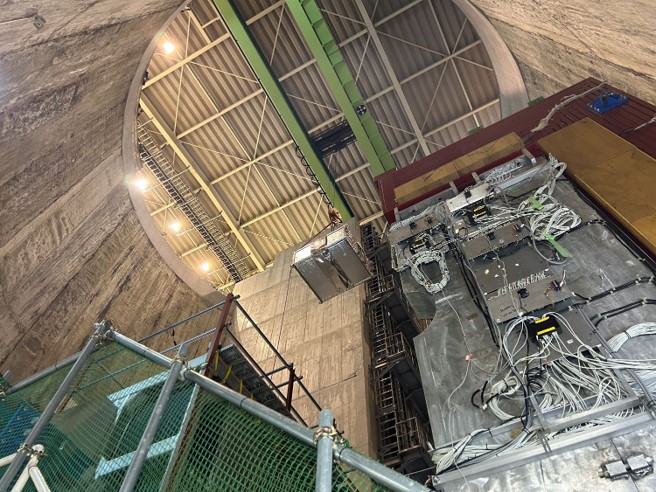
On September 8th, High-Angle TPC was moved down to the near-detectors using a large crane.
-
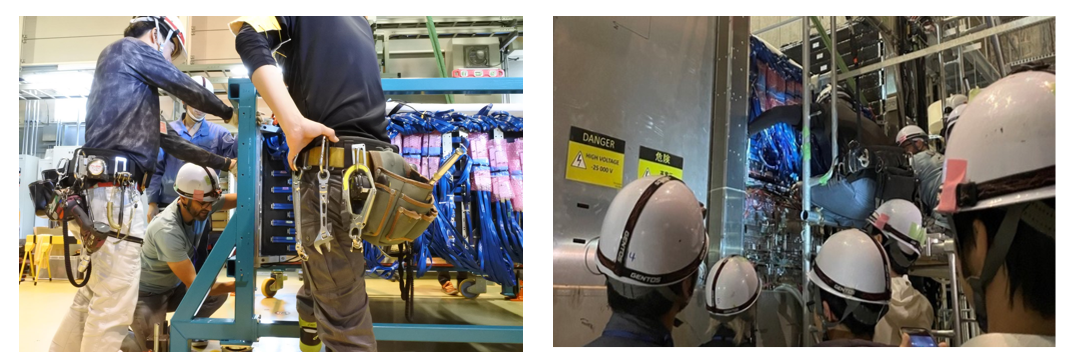
On October 12th, researchers attentively overseeing the installation of the SuperFGD.
-
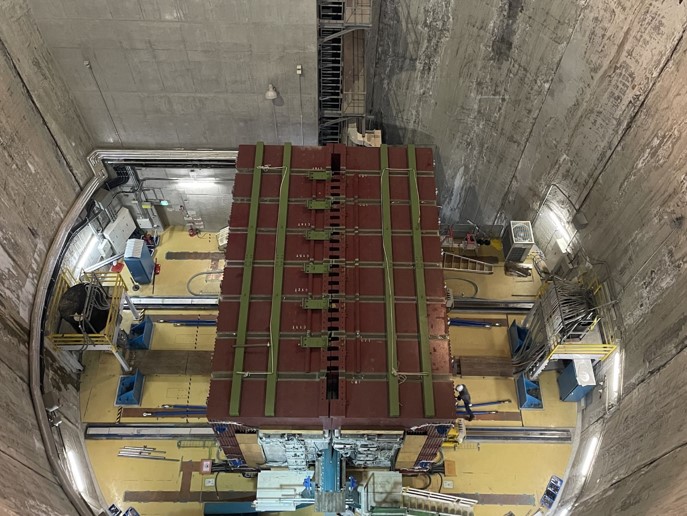
On November 14th, the magnet of neutrino near-detectors was closed.
Toward the Hyper-Kamiokande Experiment
Hyper-Kamiokande detector is under construction aiming to start observations in 2027. Measuring the neutrino-nucleus interactions with the newly installed near-detectors will also improve the sensitivity of the Hyper-Kamiokande experiment (*2).
[Dr. Matsubara] The Hyper-Kamiokande experiment will be able to observe many neutrino interactions, resulting in a greater amount of data. The increase in data will reduce the statistical error (error due to insufficient data), but the systematic error will have a relatively large impact. This can limit the sensitivity of the experiment, so reducing systematic errors with this new detector is critical also in future.
After the start of beam operation in December 2023, neutrino event candidates were successfully observed with the new detectors during a technical run. For further information, please visit the following website: https://www.kek.jp/en/press-en/202401171405/
The remaining High-Angle TPC and TOF detectors will be installed in the spring of 2024, completing the series of upgrades.
-
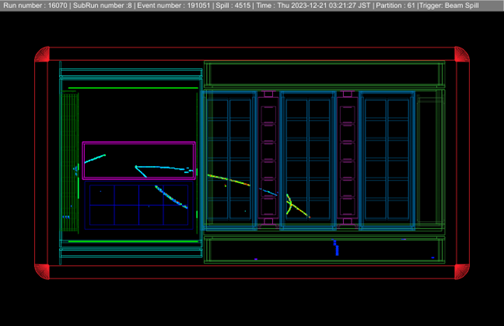
An event display of a neutrino event candidate interacted in the SuperFGD with a track entering the bottom HA-TPC while another track is entering the conventional detectors.
*1 Neutrino oscillation
Neutrinos are electrically neutral elementary particles which have less than one-millionth the mass of the lightest quarks and electrons. Neutrinos seldom interact with other matter. While we cannot sense them while they are around us, hundreds of trillions of neutrinos emitted from the sun are passing through our bodies every second. There are three types (generations) of neutrinos: electron neutrinos, muon neutrinos, and tau neutrinos. It is known that the type of the neutrino changes from one to another as the neutrino travels. For example, even if a 100% pure muon neutrino beam is produced by an accelerator, some of the muon neutrinos can be observed as tau neutrinos after they travel over some distance. This phenomenon is called “neutrino oscillation”. The discovery of this phenomenon showed that neutrinos have mass and earned Prof. Takaaki Kajita the Nobel Prize in Physics in 2015 (shared with Prof. Arthur McDonald).
*2 Hyper-Kamiokande experiment
The Hyper-Kamiokande project aims next generation neutrino research and observation of proton decay. For the project, a new water Cherenkov detector with a fiducial volume about 8 times larger than the Super-Kamiokande detector is currently under construction and further increase of the neutrino beam power at J-PARC is in progress. The Hyper-Kamiokande is an international collaborative research project, consisting of about 600 researchers from 22 countries as of October 2023, aiming to start the experiment in 2027. https://www-sk.icrr.u-tokyo.ac.jp/en/hk/
T2K Experiment (Long-baseline neutrino oscillation experiment)
High-intensity neutrino beams, produced at the J-PARC Neutrino Experimental Facility, are sent to Super-Kamiokande in Kamioka, Hida-city, Gifu prefecture 295 kilometers away and observed by the Super-Kamiokande detector. The near neutrino detector at the J-PARC site observes neutrinos right after neutrino production. By observing at both sites, neutrino-behavior can be studied. The T2K experiment, named after Tokai to Kamioka (Tokai village, where J-PARC is located, and Kamioka town), is the world’s leading experiment in neutrino research with high-sensitivity. The T2K experiment involves approximately 570 researchers from 78 research institutions in 14 countries.

